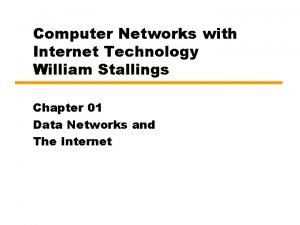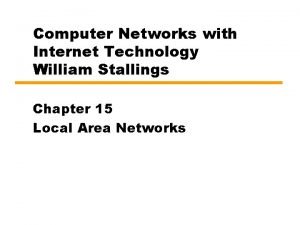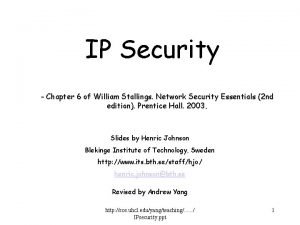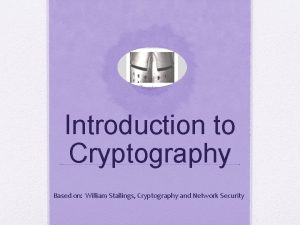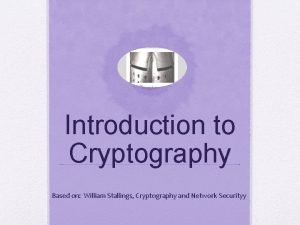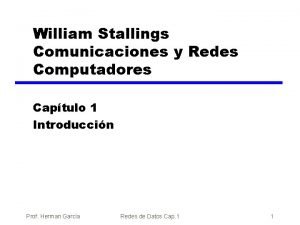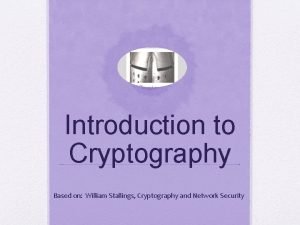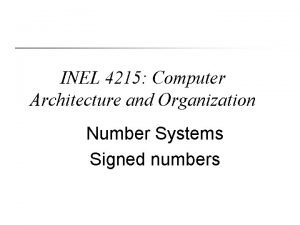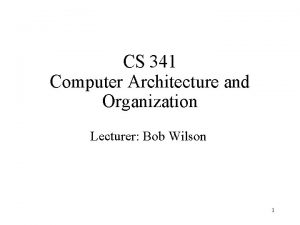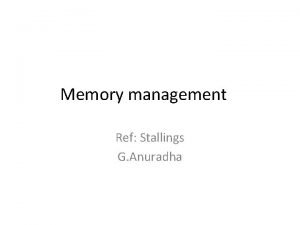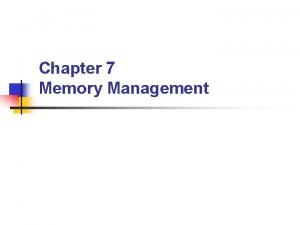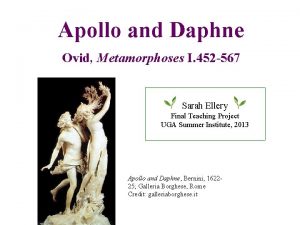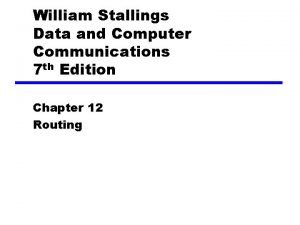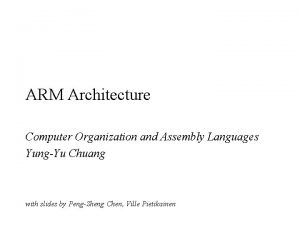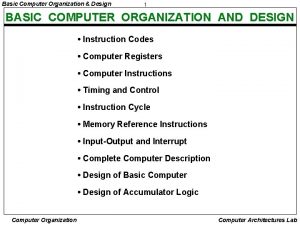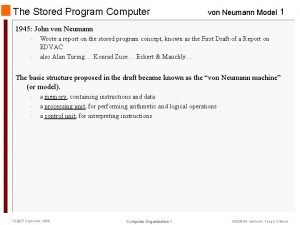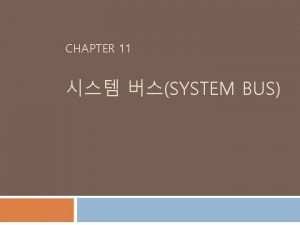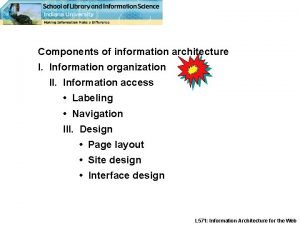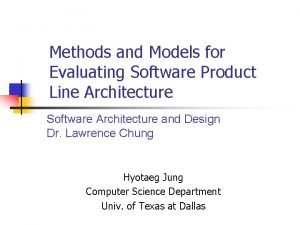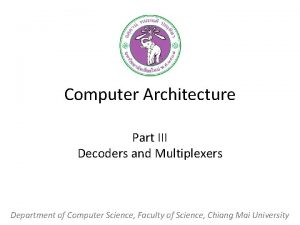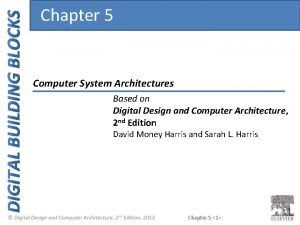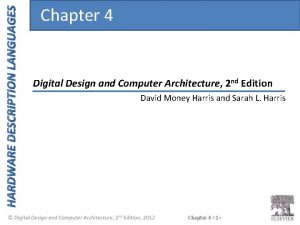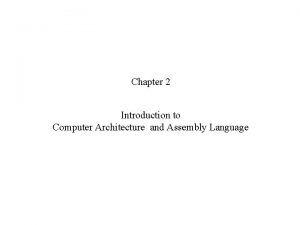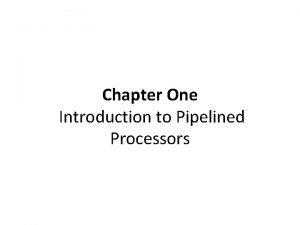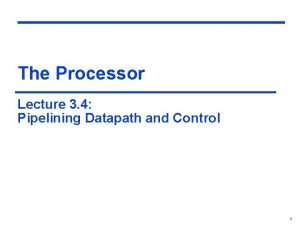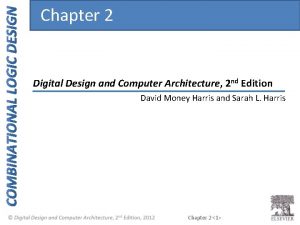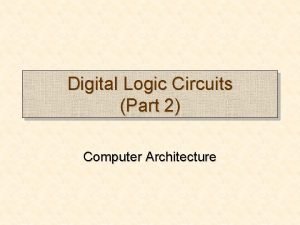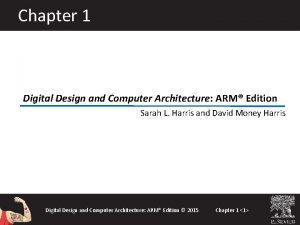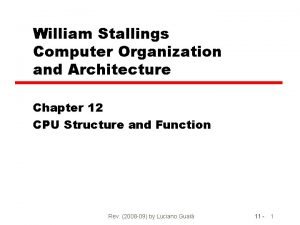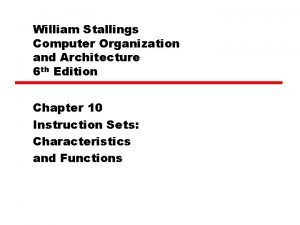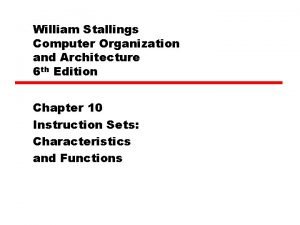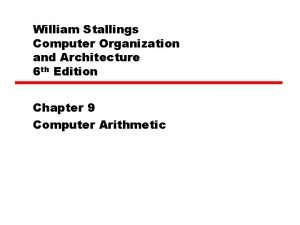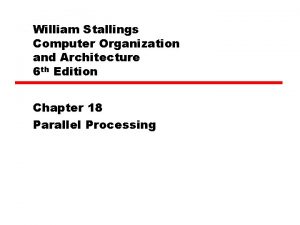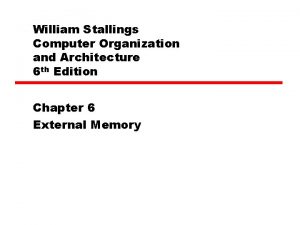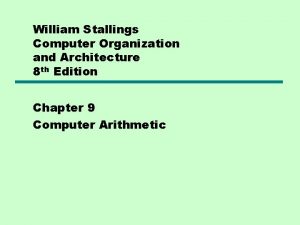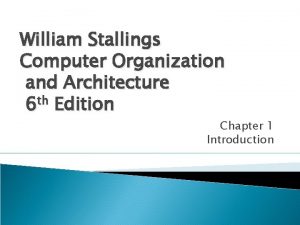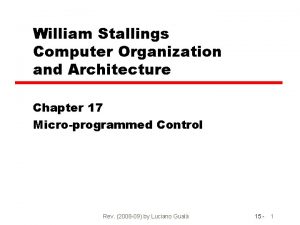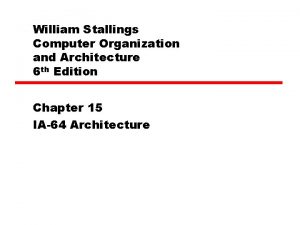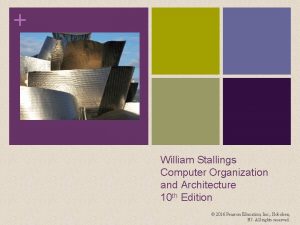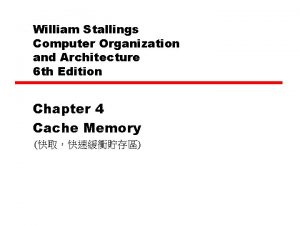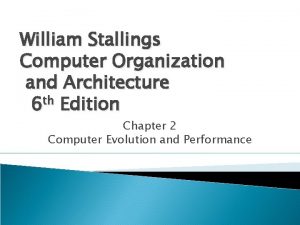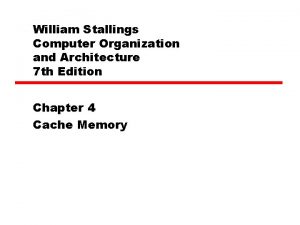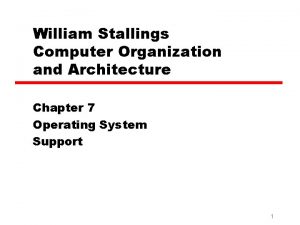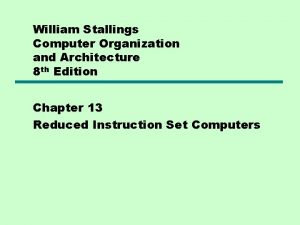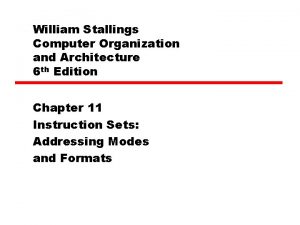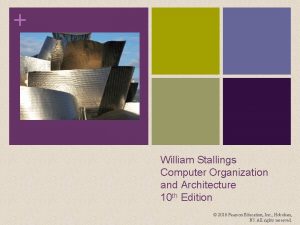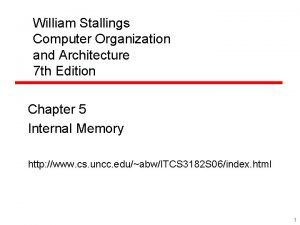William Stallings Computer Organization and Architecture 7 th































![Negative Multiplier X = [1 xn-2 xn-3…x 1 x 0] X = -2 n-1 Negative Multiplier X = [1 xn-2 xn-3…x 1 x 0] X = -2 n-1](https://slidetodoc.com/presentation_image_h/23ab965dba15b6e9a819e152264ed1e8/image-32.jpg)






















- Slides: 54

William Stallings Computer Organization and Architecture 7 th Edition Chapter 9 Computer Arithmetic

Arithmetic & Logic Unit • Does the calculations • Everything else in the computer is there to service this unit • Handles integers • May handle floating point (real) numbers • May be separate FPU (maths co-processor) • May be on chip separate FPU (486 DX +)

ALU Inputs and Outputs

Integer Representation • Only have 0 & 1 to represent everything • Positive numbers stored in binary —e. g. 41=00101001 • No minus sign, No period • Nonnegative Integers — Unsigned Integer • Sign-Magnitude • Two’s complement 128 89 = 0 64 32 16 8 4 2 1 1 0 0 1

Sign-Magnitude • • • Left most bit is sign bit 0 means positive 1 means negative +18 = 00010010 -18 = 10010010 Problems —Need to consider both sign and magnitude in arithmetic —Two representations of zero (+0 and -0)

Two’s Complement • • +3 = 00000011 +2 = 00000010 +1 = 00000001 +0 = 0000 -1 = 1111 -2 = 11111110 -3 = 11111101

Benefits • One representation of zero • Arithmetic works easily (see later) • Negating is fairly easy — 3 = 00000011 —Boolean complement gives 11111100 —Add 1 to LSB 11111101

Two’s Complement

Geometric Depiction of Twos Complement Integers

Negation Special Case 1 • • • 0= 0000 Bitwise not 1111 Add 1 to LSB +1 Result 1 0000 Overflow is ignored, so: -0=0

Negation Special Case 2 • • -128 = 10000000 bitwise not 01111111 Add 1 to LSB +1 Result 10000000 So: -(-128) = -128 X Monitor MSB (sign bit) It should change during negation

Range of Numbers • 8 bit 2 s complement —+127 = 01111111 = 27 -1 — -128 = 10000000 = -27 • 16 bit 2 s complement —+32767 = 011111111 = 215 - 1 — -32768 = 100000000 = -215 -2 n-1 ~ 2 -1

Conversion Between Lengths • • Positive number pack with leading zeros +18 = 00010010 +18 = 0000 00010010 Negative numbers pack with leading ones -18 = 1110 -18 = 1111 1110 i. e. pack with MSB (sign bit)

Bias: 2 k-1 -1 or Excess 2 k-1 -1

Excess-127 (Bias 127) • k = 8, 2 k-1 -1 = 28 -1 -1 = 127 • 8 bits: 0 ~255 -127 ~ 128 • Decimal to Binary 35 35+127 = 162 59 Excess-127: 10100010 -68+127 = Excess-127: 00111001 • Binary to Decimal Excess-127: 11000101 193 46 193 -127 = 66 Excess-127: 00101110 46 -127 = -81

Addition and Subtraction • Normal binary addition • Monitor sign bit for overflow • Overflow Rule: — If two numbers are added, and there are both positive or both negative, then overflow occurs if and only if the result has the opposite sign. • Take twos complement of subtrahend add (減數 ) (被減數) to minuend —i. e. a - b = a + (-b) • So we only need addition and complement circuits


M-S

Full Adder See Figure B. 22

4 -bit Adder

Hardware for Addition and Subtraction

Multiplication • • Complex Work out partial product for each digit Take care with place value (column) Add partial products


Unsigned Binary Multiplication (1011) (1101)

Execution of Example

Flowchart for Unsigned Binary Multiplication

Multiplying Negative Numbers • This does not work! • Solution 1 —Convert to positive if required —Multiply as above —If signs were different, negate answer • Solution 2 —Booth’s algorithm

Principle of Booth’s Algorithm 01000000 = 00111111 + 1 = 00111000 + 00000111+1 = 00111000 + 00001000 -1+1 = 00111000 + 00001000 00111000 = 01000000 - 00001000 2 n+1 = (2 n + 2 n-1 …+ 2 n-k-1 + 2 n-k-2 +…+1)+1 2 n + 2 n-1 + …+ 2 n-k = 2 n+1 – (2 n-k-1 + 2 n-k-2 …+1) – 1 = 2 n+1 – (2 n-k – 1) – 1 = 2 n+1 – 2 n-k M (00011110) = M (24+23+22+21) = M (16+8+4+2) = M (30) = M (32 -2) = M (25 -21) = M 25 - M 21

Booth’s Algorithm M A Q Q 0 Q-1

Example of Booth’s Algorithm 7 3

Arithmetic Shift • Arithmetic Right Shift 000110100100 000011010010 • Arithmetic Left Shift 01010011 1010 00100110 11010100
![Negative Multiplier X 1 xn2 xn3x 1 x 0 X 2 n1 Negative Multiplier X = [1 xn-2 xn-3…x 1 x 0] X = -2 n-1](https://slidetodoc.com/presentation_image_h/23ab965dba15b6e9a819e152264ed1e8/image-32.jpg)
Negative Multiplier X = [1 xn-2 xn-3…x 1 x 0] X = -2 n-1 + (xn-2 2 n-2) + (xn-3 2 n-3 ) +…+ (x 1 21 ) + (x 0 20 ) X = [111… 10 xk-1 xk-2…x 1 x 0] X = 2 n-1 + 2 n-2 +… + 2 k+1 +(xk-1 2 k-1 ) +…+ (x 0 20 ) = 2 n-1 + (2 n-1 2 k+1) +(xk-1 2 k-1 ) +…+ (x 0 20 ) = 2 k+1 +(xk-1 2 k-1 ) +…+ (x 0 20 ) 10000000 11100000 11110000 76543210 = -27+26 = -26+25 = -25+24 = -24 11111000 = -23 11111100 = -22 11111110 = -21 1111 = -20

Division • More complex than multiplication • Negative numbers are really bad! • Based on long division (長除法)

Division of Unsigned Binary Integers

Flowchart for Unsigned Binary Division M A Q Q 0

Real Numbers • Numbers with fractions • Could be done in pure binary — 1001. 1010 = 24 + 20 +2 -1 + 2 -3 =9. 625 • Where is the binary point? • Fixed? —Very limited • Moving? —How do you show where it is?

Floating Point (mantissa) • +/-. significand x 2 exponent • Point is actually fixed between sign bit and body of mantissa(尾數) • Exponent indicates place value (point position) Biased representation:

Floating Point Examples 8 -bit biased value: 28 -1 -1 = 27 -1 = 127 (01111111) 00010100 + 01111111 = 10010011 00010100 + 01111111 = 01101011

Signs for Floating Point • Mantissa is stored in 2 s complement • Exponent is in excess or biased notation —e. g. Excess (bias) 127 means — 8 bit exponent field —Pure value range 0 -255 —Subtract 127 to get correct value —Range -127 to +128

(0. 4375)10 = (x)2 x = 0. 0111 0. 4375 × 2 0. 875 × 2 1. 0

Normalization ± 1. bbb…b × 2 ±E • FP numbers are usually normalized • i. e. exponent is adjusted so that leading bit (MSB) of mantissa is 1 • Since it is always 1 there is no need to store it • (c. f. Scientific notation where numbers are normalized to give a single digit before the decimal point • e. g. 3. 123 x 103)

FP Ranges • For a 32 bit number — 2 s Complement: -231 ~ 231 -1 — Floating number – Negative numbers: -(2 -2 -23) x 2128 ~ -2 -127 – Positive numbers: 2 -127 ~ (2 -2 -23) x 2128 • Accuracy —The effect of changing LSB of mantissa — 23 bit mantissa 2 -23 1. 2 x 10 -7 —About 6 decimal places

Expressible Numbers

Density of Floating Point Numbers

IEEE 754 • • Standard for floating point storage 32 and 64 bit standards 8 and 11 bit exponent respectively Extended formats (both mantissa and exponent) for intermediate results

IEEE 754 Formats

Page 313 (11111110) (00000001)



FP Arithmetic +/Four basic phases: • Check for zeros • Align significands (adjusting exponents) • Add or subtract significands • Normalize result

FP Addition & Subtraction Flowchart

FP Arithmetic x/ • • • Check for zero Add/subtract exponents Multiply/divide significands (watch sign) Normalize Round All intermediate results should be in double length storage

Floating Point Multiplication

Floating Point Division
 William stallings computer organization and architecture
William stallings computer organization and architecture William stallings data and computer communications
William stallings data and computer communications William stallings computer networks
William stallings computer networks William stallings computer networks
William stallings computer networks William stallings network security essentials 5th edition
William stallings network security essentials 5th edition Kr
Kr William stallings
William stallings Congruence relation
Congruence relation Stallings william comunicaciones y redes de computadores
Stallings william comunicaciones y redes de computadores Cryptography william stallings
Cryptography william stallings Computer architecture and organisation
Computer architecture and organisation Computer organization and architecture 10th solution
Computer organization and architecture 10th solution Iit kharagpur virtual lab coa
Iit kharagpur virtual lab coa Introduction to computer organization and architecture
Introduction to computer organization and architecture Spec rating formula in computer organization
Spec rating formula in computer organization Computer organization and architecture 10th edition
Computer organization and architecture 10th edition Risc vs cisc example
Risc vs cisc example 1 s complement
1 s complement Computer architecture and organization
Computer architecture and organization Process organization in computer organization
Process organization in computer organization 3 bus architecture
3 bus architecture Instruction set architecture in computer organization
Instruction set architecture in computer organization Memory organization in computer architecture
Memory organization in computer architecture Basic structure of computer system
Basic structure of computer system Complete computer description in computer organization
Complete computer description in computer organization Design of basic computer
Design of basic computer Stallings garbage pickup
Stallings garbage pickup Garbage pickup stallings
Garbage pickup stallings Ovid metamorphoses apollo and daphne
Ovid metamorphoses apollo and daphne Metodo stallings
Metodo stallings Lh stallings
Lh stallings Point by point organization example
Point by point organization example Arm in computer organization
Arm in computer organization Interrupt cycle flow chart
Interrupt cycle flow chart Basic computer design
Basic computer design Memory locations and addresses in computer organization
Memory locations and addresses in computer organization Synchronous and asynchronous bus in computer organization
Synchronous and asynchronous bus in computer organization Call and return architecture in software engineering
Call and return architecture in software engineering Components of information architecture
Components of information architecture Bapo business architecture process organization
Bapo business architecture process organization Timing and control in computer architecture
Timing and control in computer architecture Evolution of computer architecture
Evolution of computer architecture Digital design and computer architecture: arm edition
Digital design and computer architecture: arm edition Non linear pipeline
Non linear pipeline Digital design and computer architecture
Digital design and computer architecture What is mux in computer architecture
What is mux in computer architecture Digital design and computer architecture
Digital design and computer architecture Digital design and computer architecture
Digital design and computer architecture Assembly language and computer architecture
Assembly language and computer architecture Hazard detection and resolution in computer architecture
Hazard detection and resolution in computer architecture Datapath pipeline
Datapath pipeline Bubble pushing example
Bubble pushing example Digital logic and computer architecture
Digital logic and computer architecture Verb 99 noun 62
Verb 99 noun 62 Digital design and computer architecture: arm edition
Digital design and computer architecture: arm edition


